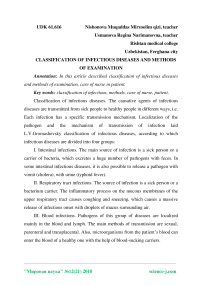Classification of infectious diseases and methods of examination
Автор: Nishonova Muqaddas Mirzoolim Qizi, Usmanova Regina Narimanovna
Журнал: Мировая наука @science-j
Рубрика: Основной раздел
Статья в выпуске: 12 (21), 2018 года.
Бесплатный доступ
In this article described classification of infectious diseases and methods of examination, care of nurse in patient.
Classification of infectious, methods, care of nurse, patient
Короткий адрес: https://sciup.org/140263328
IDR: 140263328
Текст научной статьи Classification of infectious diseases and methods of examination
Classification of infectious diseases. The causative agents of infectious diseases are transmitted from sick people to healthy people in different ways, i.e. Each infection has a specific transmission mechanism. Localization of the pathogen and the mechanism of transmission of infection laid L.V.Gromashevsky classification of infectious diseases, according to which infectious diseases are divided into four groups:
-
I. Intestinal infections. The main source of infection is a sick person or a carrier of bacteria, which excretes a huge number of pathogens with feces. In some intestinal infectious diseases, it is also possible to release a pathogen with vomit (cholera), with urine (typhoid fever).
-
II. Respiratory tract infections. The source of infection is a sick person or a bacterium carrier. The inflammatory process on the mucous membranes of the upper respiratory tract causes coughing and sneezing, which causes a massive release of infectious onset with droplets of mucus surrounding air.
-
III. Blood infections. Pathogens of this group of diseases are localized mainly in the blood and lymph. The main methods of transmission are sexual, parenteral and transplacental. Also, microorganisms from the patient’s blood can enter the blood of a healthy one with the help of blood-sucking carriers.
-
IV. Infections of the integument. Contagious onset usually penetrates damaged outer integument. This group of infections includes: rabies, infection of which occurs when the bite is sick animals; a tetanus whose pathogen penetrates the wound; anthrax transmitted by direct contact from animals or through spores contaminated with spores. It should be noted that in some diseases (plague, tularemia, anthrax, etc.) a multiple mechanism of transmission of infection can be observed.
Laboratory and instrumental examination methods. Confirming the diagnosis of an infectious disease is carried out using special laboratory research methods:
-
1. Bacterioscopic.
-
2. Bacteriological.
-
3. Serological.
-
4. Immunofluorescent.
-
5. Biological.
Bacterioscopic method - this method is rarely resorted to, since in the material from the patient, apart from the causative agents of the disease, there is a concomitant microflora, which under the microscope may look like the causative agent of infection. But for diseases such as malaria, relapsing fever, meningococcal infection, direct microscopy is necessary. More often by this method, blood, lymph, cerebrospinal fluid is examined.
The bacteriological method is the sowing of material on artificial nutrient media to isolate the culture of the pathogen, to determine sensitivity to antibiotics.
Serological method - the detection of antibodies in the serum or antibodies in the material from the patient. All serological studies are based on the formation of the antigen – antibody complex, visually determined by the formation of a precipitate, i.e. agglutination.
RA - agglutination reaction (Vidal reaction - in typhoid fever, paratyphoid fever, Wright reaction - in brucellosis) - the basis of all serological reactions: rtha, phlegic cancer, RSK (modification of RA). Evaluation of the results is carried out by antibody titer or by increasing titer.
Immunofluorescence Reaction (ELISA) - the essence of the method lies in the use of the luminescent variant of the “antigen – antibody” reaction, which occurs when the antigens of bacteria are combined with the corresponding specific antibodies labeled with fluorescent dyes. A preliminary result can be issued after 2 hours.
The virologic method is the isolation of a virus by planting on specific media (tissue culture, chicken broth).
Parasitological diagnostic method - the material is delivered in a warm form, smears are prepared and viewed under a microscope (feces).
Skin Allergy Tests (CAP) - the allergen is injected intradermally or applied to scarification skin. After 24–48 hours, the patient develops an inflammatory reaction at the site of allergen injection (Burne test for brucellosis; manta test for tuberculosis). For the diagnosis of infectious diseases, instrumental methods of research are used: X-ray, gastroduodenoscopic, ultrasound, fibrocolonoscopy, X-ray computed tomography, scanning.
Biological method - infection of laboratory animals to cause the corresponding disease.
The goal of nursing care for patients with infectious diseases and the role of nurses. The success of treating an infectious patient largely depends on the organization of care by the medical staff. Proper treatment, toilet of the patient, feeding and other procedures are associated with a clear and competent work of the nurse. A nurse should make sure that the patient's bed is not only clean, but also comfortable, so that the patient can take all the necessary items without straining, so that the mattress is elastic and there are no folds on the sheet. A nurse should be attentive, patient and precautionary, remembering that an infectious patient is helpless, irritable, picky because of high temperature and intoxication.
Список литературы Classification of infectious diseases and methods of examination
- Tolkacheva OV, Zinkovskaya I.V. "The basics of nursing go affairs. Tashkent, Tasvir, 2008.
- Pokrovsky V.I., Pak S.G., Briko N.I., Danilkin B.K. "Infectious diseases and epidemiology." Moscow, 2007.
- Edited by Acad. RAMS, prof. IN AND. Pokrovsky, prof. R.I. Briko. "A guide to practical exercises on epidemiology of infectious diseases. Moscow, 2005.


